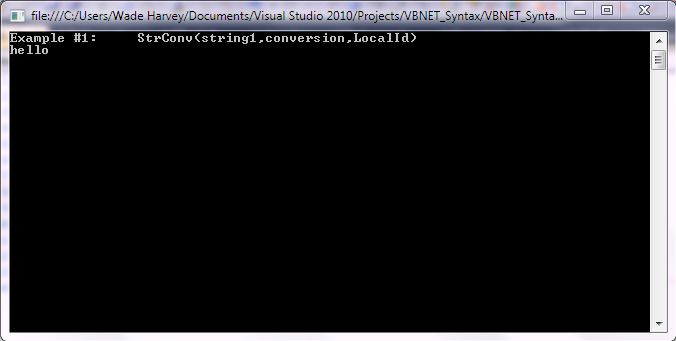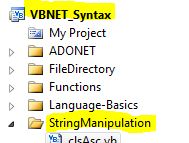VB.NET StrConv() – Code Sample Syntax Example
Posted by asp.net videos on Sunday, February 13, 2011 · Leave a Comment
Premium (Not Free) Video Tutorials
Free Video Tutorials & Free Tools
Premium (Not Free) Video Tutorials
Free Video Tutorials & Free Tools
VB.NET StrConv Example – Code Sample Syntax
Abstract: – Illustrates using VB.NET StrConv Code Example.
*** 2. StrConv Syntax ***
Purpose:
returns string converted as specified
Syntax:
StrConv(string1,conversion,LocalId)
| Parameters |
Description |
string1 |
Required. String expression to be converted.
|
| conversion |
Required. VbStrConv member. The enumeration
value specifying the type of conversion to perform.
Enumeration(member) Description()
VbStrConv.None() Performs no conversion
VbStrConv.LinguisticCasing() Uses linguistic rules for casing, rather than File System
(default). Valid with VbStrConv.UpperCase and VbStrConv.LowerCase only.
VbStrConv.Uppercase() Converts the string to uppercase characters.
VbStrConv.Lowercase() Converts the string to lowercase characters.
VbStrConv.ProperCase() Converts the first letter of every word in string to uppercase.
VbStrConv.Wide* Converts narrow (half-width) characters in the string to wide
(full-width) characters.
VbStrConv.Narrow* Converts wide (full-width) characters in the string to narrow
(half-width) characters.
VbStrConv.Katakana** Converts Hiragana characters in the string to Katakana characters.
VbStrConv.Hiragana** Converts Katakana characters in the string to Hiragana characters.
VbStrConv.SimplifiedChinese* Converts Traditional Chinese characters to Simplified Chinese.
VbStrConv.TraditionalChinese* Converts Simplified Chinese characters to Traditional Chinese.
* – Chinese locales only
** – Japanese locales only
|
| LocalId |
Optional. The LocaleID value, if different from the system LocaleID value.
(The system LocaleID value is the default.)
|
| Result Data Type |
Description |
string |
Converted string expression
|
*** 3. StrConv – Quick Example ***
|
Dim strString1 As String = “Hello”
Console.WriteLine(StrConv(strString1, VbStrConv.Lowercase)) ‘Returns hello
|
*** 4. StrConv – Full Example ***
StrConv Example Output Screenshot

Step 1: Click Visual Basic to Cut-n-paste code into clsStrConv.vb
Public Class clsStrConv
Public Sub Main()
'****************************************************************************************
' Purpose: returns string converted as specified
'
' Syntax: StrConv(string1,conversion,LocalId)
'
' Parameter1: string1 - Required. String expression to be converted.
'
' Parameter2: conversion - Required. VbStrConv member. The enumeration
' value specifying the type of conversion to perform.
' Enumeration(member) Description()
' VbStrConv.None() Performs no conversion
' VbStrConv.LinguisticCasing() Uses linguistic rules for casing, rather than File System
' (default). Valid with VbStrConv.UpperCase and VbStrConv.LowerCase only.
' VbStrConv.Uppercase() Converts the string to uppercase characters.
' VbStrConv.Lowercase() Converts the string to lowercase characters.
' VbStrConv.ProperCase() Converts the first letter of every word in string to uppercase.
' VbStrConv.Wide* Converts narrow (half-width) characters in the string to wide
' (full-width) characters.
' VbStrConv.Narrow* Converts wide (full-width) characters in the string to narrow
' (half-width) characters.
' VbStrConv.Katakana** Converts Hiragana characters in the string to Katakana characters.
' VbStrConv.Hiragana** Converts Katakana characters in the string to Hiragana characters.
' VbStrConv.SimplifiedChinese* Converts Traditional Chinese characters to Simplified Chinese.
' VbStrConv.TraditionalChinese* Converts Simplified Chinese characters to Traditional Chinese.
' * - Chinese locales only
' ** - Japanese locales only
'
' Parameter3: LocalId - Optional. The LocaleID value, if different from the system LocaleID value.
' (The system LocaleID value is the default.)
'
' Result: string - Converted string expression
'
' Quick Example: Dim strString1 As String = "Hello"
' Console.WriteLine(StrConv(strString1, VbStrConv.Lowercase)) 'Returns hello
'
'****************************************************************************************
'****************************************************************************************
' Example #1: StrConv(string1,conversion,LocalId) - returns string converted as specified
'****************************************************************************************
Console.WriteLine("Example #1: StrConv(string1,conversion,LocalId) ")
Dim strString1 As String = "Hello"
Console.WriteLine(StrConv(strString1, VbStrConv.Lowercase)) 'Returns hello
'write blank line to make output easier to read
Console.WriteLine()
'Prevent console from closing before you press enter
Console.ReadLine()
End Sub
End Class |
Public Class clsStrConv
Public Sub Main()
'****************************************************************************************
' Purpose: returns string converted as specified
'
' Syntax: StrConv(string1,conversion,LocalId)
'
' Parameter1: string1 - Required. String expression to be converted.
'
' Parameter2: conversion - Required. VbStrConv member. The enumeration
' value specifying the type of conversion to perform.
' Enumeration(member) Description()
' VbStrConv.None() Performs no conversion
' VbStrConv.LinguisticCasing() Uses linguistic rules for casing, rather than File System
' (default). Valid with VbStrConv.UpperCase and VbStrConv.LowerCase only.
' VbStrConv.Uppercase() Converts the string to uppercase characters.
' VbStrConv.Lowercase() Converts the string to lowercase characters.
' VbStrConv.ProperCase() Converts the first letter of every word in string to uppercase.
' VbStrConv.Wide* Converts narrow (half-width) characters in the string to wide
' (full-width) characters.
' VbStrConv.Narrow* Converts wide (full-width) characters in the string to narrow
' (half-width) characters.
' VbStrConv.Katakana** Converts Hiragana characters in the string to Katakana characters.
' VbStrConv.Hiragana** Converts Katakana characters in the string to Hiragana characters.
' VbStrConv.SimplifiedChinese* Converts Traditional Chinese characters to Simplified Chinese.
' VbStrConv.TraditionalChinese* Converts Simplified Chinese characters to Traditional Chinese.
' * - Chinese locales only
' ** - Japanese locales only
'
' Parameter3: LocalId - Optional. The LocaleID value, if different from the system LocaleID value.
' (The system LocaleID value is the default.)
'
' Result: string - Converted string expression
'
' Quick Example: Dim strString1 As String = "Hello"
' Console.WriteLine(StrConv(strString1, VbStrConv.Lowercase)) 'Returns hello
'
'****************************************************************************************
'****************************************************************************************
' Example #1: StrConv(string1,conversion,LocalId) - returns string converted as specified
'****************************************************************************************
Console.WriteLine("Example #1: StrConv(string1,conversion,LocalId) ")
Dim strString1 As String = "Hello"
Console.WriteLine(StrConv(strString1, VbStrConv.Lowercase)) 'Returns hello
'write blank line to make output easier to read
Console.WriteLine()
'Prevent console from closing before you press enter
Console.ReadLine()
End Sub
End Class Step 2: Click Visual Basic to Cut-n-paste code into Module1.vb
Module Module1
Sub Main()
Dim myclsStrConv As New clsStrConv
myclsStrConv.Main()
End Sub
End Module |
Module Module1
Sub Main()
Dim myclsStrConv As New clsStrConv
myclsStrConv.Main()
End Sub
End Module Prerequistes:
- Install Visual Basic (Express or Standard Edition)
- Install SQL Server Express
- Download Northwind and pubs Database
- Attach Northwind Database to Databases in Sql Express
- Attach pubs Database to Databases in Sql Express
Notes:
- Console Application is used to simplify things, but Windows Forms or Web Forms could also be used
- You can build a library of syntax examples by using same project over and over and just commenting out what you do not want to execute in Module1.vb
Instructions:

- Use Visual Basic 2010 Express or Standard Edition
- Create new project;
- Click File/New Project
- Select Console Application Template
- Select Visual Basic for Language
- name of project could be VBNET_Syntax.
- Add New folder named “StringManipulation”
- Right-click project name in solution explorer;
- add new folder;
- name of folder could be: StringManipulation
- Add Class Named clsStrConv to StringManipulation folder
- Right-click StringManipulation folder;
- add new item;
- Select class
- Class name could be clsStrConv
- Click on Visual Basic in code in step 1 above to copy code into clsStrConv.vb
- Click on Visual Basic in code in step 2 above to copy code into Module1.vb
- Click green arrow or press F5 to run program
|
 Download Source Code for All VB Console Examples in One Project – source code for hundreds of VB.NET console examples neatly organized in a single project.
Download Source Code for All VB Console Examples in One Project – source code for hundreds of VB.NET console examples neatly organized in a single project.
